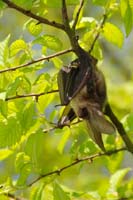Bats in the Woods – Bat surveys

Now that the weather has turned colder, most bats will have found their spot to hibernate for the winter. November is a good time to carry out a bat survey of your wood, when the leaves have dropped from the trees and it’s easier to see possible bat roosts.
Are there bats in your woodland? Almost certainly: most woodland, unless it is very young, will have bats roosting somewhere. Woodland provides the perfect habitat, from a stand of few trees to large woodlands. Clefts in branches, woodpecker or rot holes and loose bark make good roosting spots, and the insects that gather around trees provide food. Five British species are woodland specialists: Bechstein’s bat, the Barbastelle, the Natterer’s, the Noctule, the Lesser Horshoe and the Brown Long-eared bat.
There are some factors that increase the likelihood of there being roosts. Obviously, mature trees are more likely to provide the nooks and crannies that bats like. For the same reason, dead, standing trees are popular, or trees, young or old, with damage. Wind-thrown trees leaning up against one another are also good. Ivy and other dense climbers can give cover too. Hedgerows linking woodland areas are important as “traffic routes”, allowing bats and other creatures to move under cover. Derelict buildings, underground structures, drystone walls and bridges are all built features that can attract bats. And you can, of course, put up your own bat boxes.
Bats need a good source of food too. Water - ponds, streams, and ditches for example - encourages the insect population, as do shrubby wood edges and rides. In general, bats like a little bit of untidiness
.
It is worth taking the time to do a walk-through survey. Bats and their roosts are protected and it is part of good woodland management to make allowances for them. All you will need are a pair of binoculars and a pencil and paper for notes. Look out for likely trees and make a note of them – you may be able to see black bat droppings underneath. They will not use one roost continuously, they move around, but once they have established a favoured spot they tend to return to it.
Comprehensive advice is available in the Forestry Commission’s booklet “Woodland Management for Bats” . The Bat Conservation Trust can also provide help and advice and run a Bat Helpline. If you should find a bat and think it’s injured, try to avoid picking it up unless you are wearing thick gloves – there is a very small risk of the bat carrying a rabies-related virus and they can bite. Best is to put something like a shoe box over the top of it and slide a piece of cardboard underneath. The BCT can usually put you in touch with someone locally who has experience in treating injured bats.
Comments are closed for this post.
Discussion
If you would like to learn more about bats, legislation and even see some live ones, come along to the small woodland owners group meeting on the 8th Nov, in Flimwell, East Sussed. See our website for more details
http://www.woodlands.co.uk/swog
The event is free of charge, email me if you are interested
[email protected]
Hi This is Carolyn. Im a freelance ecologist. Please contact me if you require your woodland surveying for bats. I have a bat detector, enodoscope for looking into hollow trees. I can also survey for the presence of other mammals, insects birds and plants.
Please contact me on [email protected]

All bats use woodlands and features such as hedgerows to some degree, either to roost, forage in, above (noctule bat)or along the edges of. November is a good time for visibility as foliage has dropped, making the identification of holes and cracks which could be used by bats easier to see. The problem with surveying for bats in November is that (depending on the weather) bats should be starting to slow down and are less active. Aerial inspections of potential tree roosts can help here, or if that is not possible, remember the position of the tree and then come back in the summer months when bats are more active, and you should get a better result.
For any more info contact us through the website below
http://www.ues.org.uk/services/bat-surveys
Regards
Stewart
Stewart
25 January, 2011